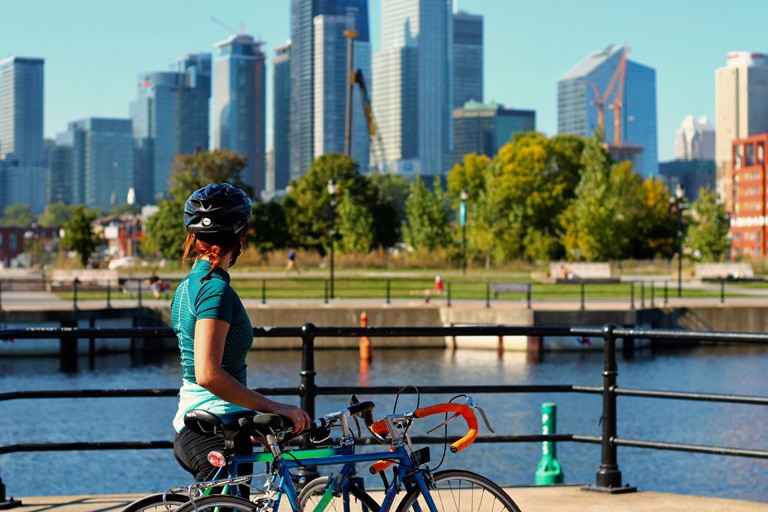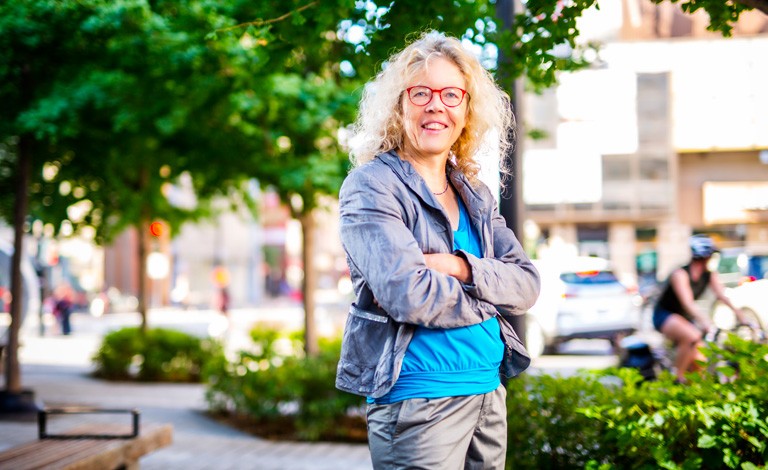How do we build urban resilience in the face of crises like COVID-19?

The coronavirus pandemic has tested the resilience of cities around the world. It has revealed gaps in governance, urban infrastructure and the provision of critical services. It has put a strain on health-care systems, global supply chains and the economy.
100 Resilient Cities defines urban resilience as “the capacity of individuals, communities, institutions, businesses and systems within a city to survive, adapt and grow no matter what kinds of chronic stresses and acute shocks they experience.”
Building resilience requires a holistic understanding of the systems that make up a city — the risks and interdependencies. It’s no small task, but it’s the life’s work of Concordia’s Canada Excellence Research Chair in Smart, Sustainable and Resilient Communities and Cities. Ursula Eicker has spent the larger part of her career developing urban transformation strategies for cities around the world.
“Cities are complex systems that can plan and prepare to react well to expected and unexpected hazards or stresses,” she says on a Zoom video call from her downtown apartment.
“Montreal is a great example of a city with solidarity neighbourhoods, where people can connect and where buildings are still low enough to experience street life — and sing from balconies!”
The physicist and expert on renewable energies and building technology discusses the possible impacts of the COVID-19 pandemic on cities and what this can mean for Montreal’s future coming out of it.
 Ursula Eicker: “I think this crisis has shown just how much social cohesion and inclusion matter.”
Ursula Eicker: “I think this crisis has shown just how much social cohesion and inclusion matter.”
‘This could be a great chance for urban transformation toward a more sustainable, just and healthy city’
What has this pandemic revealed about the importance of building resilience in a city?
Ursula Eicker: First, the healthier we are, the less vulnerable we are in the face of a pandemic. A population is healthier the more people actively move, cycle and walk. Plus, fewer cars in cities means cleaner air and reduced pollution, which helps reduce respiratory diseases. The economic shutdown over the last few weeks led to strong decreases in nitrogen dioxide concentrations resulting from transportation. In fact, this is already visible on satellite images over Montreal, but also in Europe, China and elsewhere.
Second, social cohesion and inclusivity are very important among citizens, whose solidarity in times of crisis supports and protects the most vulnerable groups of society. Solidarity behaviour does not just happen; it needs to be fostered by strong community building, built environments and public spaces that support communication. It also requires daily inclusion of disadvantaged groups into city life. The most vulnerable groups during pandemics are senior citizens and they are often facing social isolation that we should aim to avoid.
In terms of controlling community spread, a contentious topic that’s come up is contact tracing — using apps and person-tracking to quickly trace and warn others of infections. This could be key for faster deconfinement and safer cities, but of course there is an inherent risk in data misuse. China, for example, has gone very far in limiting individual freedoms for the sake of health safety. In democratic societies such as ours, trust in data protection is essential to achieve voluntary participation in such digital approaches. Citizen ownership of data helps to build such trust.
Finally, it became clear that dependence on global supply chains made cities increasingly vulnerable. This includes construction material and electronics from China, but also active pharmaceutical ingredients needed to manufacture drugs. Increasing local or regional production and diversifying supply chains would help.
Will the COVID-19 pandemic alter how we view mobility and transportation?
UE: Yes — and hopefully this will persuade communities to encourage active modes of transportation that improve health and reduce pollution.
Several cities have already converted streets to pedestrian zones and rapidly increased bike lanes. Bogota, Colombia, for example, created 22 kilometres of new bike lanes overnight. New York, Winnipeg and Calgary have also seen surges in biking during the outbreak.
Montreal has taken rather timid measures to increase space for pedestrians and bikers. They opened exclusive access to the Charlevoix Bridge to provide a crossing of the Lachine Canal. And they widened the sidewalks along select thoroughfares in boroughs such as Plateau-Mont-Royal and Côte-des-Neiges—Notre-Dame-de-Grâce.
I would love to see a radical move this summer in Montreal to change street layouts for pedestrian and cycling priority.
How will the pandemic impact the design of public spaces and buildings?
UE: High-density cities are more vulnerable to the spread of infectious diseases. We should think about managing urban density to give people more space in the city, especially more access to green spaces. Public spaces and pedestrian areas also need expanding. On narrow sidewalks like on Sainte-Catherine Street, it will be impossible to keep adequate distance, so it’s good that redevelopment will soon be underway.
How great would it be if we could suddenly have plant cover and pedestrian zones everywhere and much fewer cars in the city? The Lithuanian and Swiss capitals Vilnius and Bern have laid out ambitious plans for a lively summer by allowing restaurants and bars to use public space at no additional costs. This would be something to look forward to in Montreal and could completely change the atmosphere in the inner city.
Also, buildings will need to be better ventilated with more fresh air to remove viruses and pollutants. Bringing in more fresh air usually means higher energy consumption. Here, solar energy use can help. Preheating the ambient air with solar energy like at Concordia’s John Molson Building and the Varennes Library can help do this for free.
What other kinds of actions can communities and businesses take now in preparation for a second pandemic?
UE: Sustainable, resilient and inclusive cities are often the outcome of good governance that encompasses effective leadership, inclusive citizen participation and efficient financing, among other things.
To this end, public officials increasingly have access to public data, enabling evidence-based decision-making. Open data is also increasingly transforming the way local governments share information with citizens, deliver services and monitor performance. It enables simultaneously increased public access to information and more direct citizen involvement in decision-making.
We have also seen a surge in home office work and teleconferencing. We have quickly learned to use new tools for virtual collaboration and, I must say that this works very well. Provided that we all have fast internet access, it is very possible and has enormous ecological benefits to have large online meetings with more than 100 participants who would otherwise have flown in from the entire world. This momentum of virtual collaboration in the city, but also internationally, should be kept and will help reduce transportation-related emissions.
For precarious food supply, more local production and reduced dependence on just-in-time production would help. The growth of urban farming is an excellent example of increased local resilience, which at the same time contributes to community and local identity building.
Given the factors explained earlier, what do you think is the most optimistic scenario for the transformation of Montreal post-COVID-19?
UE: This could be a great chance for urban transformation toward a more sustainable, just and healthy city.
If we continue reducing carbon dioxide emissions like we are now by drastically reducing individual car traffic, flights and other non-electric transportation, we would meet our CO2 reduction targets easily in the future and have cleaner air in Montreal at the same time.
Imagine our streets converted into pedestrian and cycling areas, which we need to practice distancing. The expansion of green spaces would promote biodiversity and allow us to produce some of our food locally. Allowing bars and restaurants to extensively use public space would provide a great summer atmosphere while guaranteeing social distancing. The drive toward more local and regional production would provide the much-needed support for the economy and keep the generated wealth in Quebec.
Provincial and federal government investments, which will surely come to help the industry, should be allocated into a comprehensive green new deal so that we finally mitigate climate change with high efficiency in all sectors and green energy production.
Digital technology could certainly help reduce health risks. If we can keep data in citizens’ hands and control, we would very likely see a high participation of data sharing during a health crisis, which would allow for much more specific and faster action.
But more importantly, I think this crisis has shown just how much social cohesion and inclusion matter. If we would take care to mix districts for multigenerational and multi-income levels, the elderly and low-income population could stay active and included in their neighbourhood. As much as we might enjoy high-rise buildings, structures of a more human scale are adequate for a truly resilient city where people still know and support each other.
Plus, you can’t even applaud or sing from a balcony if you are living on the 36th floor!
The CERC Smart, Sustainable and Resilient Communities and Cities team will be leading a series of conversations called Co-creating the Next-Generation Quartier, beginning on Thursday, May 7. Hosted virtually by 4TH SPACE, the event features experts from Concordia and the Montreal community who will be invited to explore what a next-generation quartier might look like, with a focus on Lachine-Est, one of the five eco-quartiers of Montreal.


